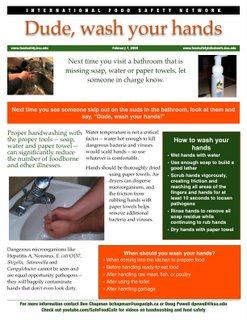 When was the last time you opened your fridge and saw this- the mold monster? Hopefully never, but if you have, you’ve probably experienced some sort of sickness related to eating the food from the fridge. Mold grows from decomposing organic material, and in addition to a foul order and slime, mold is a great indicator of food going bad. But food can be decidedly “bad” before the mold fully appears.
When was the last time you opened your fridge and saw this- the mold monster? Hopefully never, but if you have, you’ve probably experienced some sort of sickness related to eating the food from the fridge. Mold grows from decomposing organic material, and in addition to a foul order and slime, mold is a great indicator of food going bad. But food can be decidedly “bad” before the mold fully appears.
Unfortunately the busy life of student has led me to find the mold monster lurking in my fridge on more than one occasion. CNNHealth gives some great advice to college students this week: “Don’t eat mold.” Not only is it unappetizing, but molds can cause allergic reactions and respiratory problems as well as produce mycotoxins, poisonous substances that can make you sick.
I’ve definitely never gone as far to intentionally consume mold. I believe in labeling my leftovers with the date and smelling foods before eating them. It’s not a foolproof way to avoid food-borne illness from moldy foods, but it’s better than eating leftovers blindly.
CNNHealth goes on to offer additional tips to enjoy a meal from the fridge: The U.S. Department of Agriculture Food Safety and Inspection Service recommends discarding moldy bread and baked goods, because of their porous texture.
Creamy dairy products like yogurt can easily spread mold and should be discarded. Soft cheeses with high moisture content — including those that are shredded, sliced, or crumbled — can be contaminated with both mold and bacteria. So throw those away, experts advise.
Hard cheeses can be saved, as long as the mold is cut 1 inch around the spot. Because of the cheese’s hardness, the mold generally cannot penetrate deep into the product.
 Mom taught me well, to throw away any bread with the slightest bit of mold, and to keep moldy hard cheese but to cut away the mold. (Within reason of course, I’m talking about cutting off a dime-sized piece of mold, not eating a furry piece of cheese.) I also try to disinfect my fridge at least every six months.
Mom taught me well, to throw away any bread with the slightest bit of mold, and to keep moldy hard cheese but to cut away the mold. (Within reason of course, I’m talking about cutting off a dime-sized piece of mold, not eating a furry piece of cheese.) I also try to disinfect my fridge at least every six months.
What if the fridge doesn’t belong to you? Office or community fridges can be hot spots for spoiled food and moldy surfaces. The Pittsburg Post-Gazette cites a survey by the American Dietetic Association and ConAgra Foods which “found that 44 percent of office refrigerators are cleaned once a month and 22 percent are cleaned only once or twice a year.”
Clean out your fridge at home with a household kitchen cleaner – preferably something with bleach. Institute a bi-weekly cleanup day for the office fridge. These are two terrific ways to lower your risk of contracting a food-borne illness from fridge food. You can also reference the USDA’s guide on moldy food when deciding what to trash or save.
Also, don’t forget to wash your hands after touching all that mold.
.jpg)

 When was the last time you opened your fridge and saw this- the mold monster? Hopefully never, but if you have, you’ve probably experienced some sort of sickness related to eating the food from the fridge. Mold grows from decomposing organic material, and in addition to a foul order and slime, mold is a great indicator of food going bad. But food can be decidedly “bad” before the mold fully appears.
When was the last time you opened your fridge and saw this- the mold monster? Hopefully never, but if you have, you’ve probably experienced some sort of sickness related to eating the food from the fridge. Mold grows from decomposing organic material, and in addition to a foul order and slime, mold is a great indicator of food going bad. But food can be decidedly “bad” before the mold fully appears. 
 Bill Chirdon, Director of Food Safety for the State Agriculture Department said,
Bill Chirdon, Director of Food Safety for the State Agriculture Department said, The reporter called me and I gave her some stuff, but she eventually talked to food science MSc student and barfblogger Andrew Reece, who —
The reporter called me and I gave her some stuff, but she eventually talked to food science MSc student and barfblogger Andrew Reece, who —